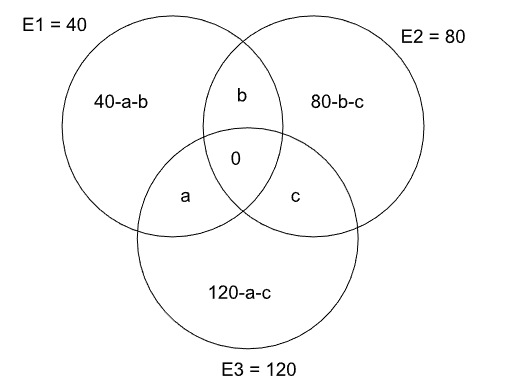Read the information given below and answer the 2 associated questions.
190 students have to choose at least one elective and at most two electives from a list of three electives: E1, E2 and E3. It is found that the number of students choosing E1 is half the number of students choosing E2, and one third the number of students choosing E3.
Moreover, the number of students choosing two electives is 50.
In addition to the given information, which of the following information is NECESSARY and SUFFICIENT to compute the number of students choosing only E1, only E2 and only E3?
Solution

Given, a+b+c=50 and a+b+c+x+y+z=190 => x+y+z=140.
Also, let E1=k => E2=2k and E3=3k ---------------1
Also, E1 = (x+a+0+b) , E2 = (y+b+0+c) , E3 = (z+a+0+c) ----------------2
From 1, E1+E2+E3 = 6k and from 2, E1+E2+E3 = (x+y+z)+2(a+b+c) = 140 + 2*50 = 240
=> 6k = 240
=> k = 40
Thus our venn diagram will look like this -

Option A: If the number of students choosing only E2 and the number of students choosing both E2 and E3 are given, then we know the value of (80-b-c) [ which will provide us with the value of (b+c) ], and the value of c. Since we know the value of c, we can get the value of b. And as the values of b and c are known, the value of a can also be known. Thus, we can find all the values.
Option B: Knowing the number of students choosing both E1 and E2, the number of students choosing both E2 and E3, and the number of students choosing both E3 and E1 is SUFFICIENT as we will get the values of a, b, and c. However, this information is not NECESSARY when calculating the number of students who choose only E1, E2, and E3 because we can calculate that with fewer conditions (like in option A).
Option C: Number of students choosing only E1, and number of students choosing both E2 and E3. Thus, we know the value of (40-a-b), which will provide us with the value of (a+b), and we know the value of c. However, the individual values of a and b cannot be known. Thus, we won't be able to find the number of students who choose only E1, only E2, and only E3.
Option D: Some extra information about a, b, and c is necessary. Thus, this option is incorrect.
Option E: Number of students choosing both E1 and E2. This will give us the value of b, and since we know the value of (a+b+c), thus we can find the value of a+c. But the individual values of a and c cannot be known. Thus, this is also incorrect.
Create a FREE account and get:
- All Quant Formulas and shortcuts PDF
- 15 XAT previous papers with solutions PDF
- XAT Trial Classes for FREE
